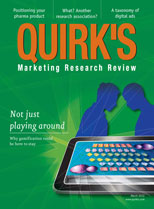Editor's note: Laura Cusumano is director at Integrated Marketing Associates, a Bryn Mawr, Pa., research firm. She can be reached at lcusumano@imalink.com. This article appeared in the March 26, 2012, edition of Quirk's e-newsletter.
Can one person effectively manage more than $1 million in health care primary research in a year? It's unlikely. TGaS Advisors reported that the health care primary research spend managed per full-time employee (FTE) increased 65 percent from $930,000 in 2007 to approximately $1.5 million in 2011.1 Historically, $1 million was a realistic figure for estimating staff requirements in health care. It has creeped up over the years but when will it stop? Even accounting for the increase in the costs of conducting research, $1 million is a real stretch for one full-time equivalent experienced researcher.
Consider that the average market research professional generally has other roles and responsibilities beyond managing primary research projects, including attendance at marketing/sales meetings; supporting other company functions such as audited data reporting or forecasting; internal departmental roles; and the possible "luxury" of professional developmental and exposure to the selling settings. In addition to those added roles and responsibilities, most market research professionals have very little assistance in the way of administrative support and staff to assist in project management activities. Even if they have an intern, often the potential assistance provided by an intern is offset by the amount of time and effort required to instruct and guide.
Commonly when the spend per FTE reaches or exceeds $1 million, the researcher generally
-
has less involvement in the research planning and monitoring process;
-
is less intimate with the findings overall;
-
becomes more of a project manager than a market research professional in reality and in the eyes of their internal customers;
-
loses control over the research process and vendor selection to purchasing; and
-
has a reduced sense of job satisfaction, contribution to the organization and professional identify.
Most health care market researchers would agree that the organization also loses out when the spend per researcher exceeds $800,000. After a certain point, companies do not benefit by increasing marketing research dollars per FTE. Frequently, health care organizations
-
receive less value for their market research spend, as the researcher is less likely to fully exploit and communicate the findings and value of the study;
-
do not have the opportunity and subsequent benefits of integrating and analyzing different studies together throughout the year;
-
create a marketing research department viewed as project managers instead of respected professionals who can contribute to the business and be part of the marketing team; and
-
will have increased job dissatisfaction and possibly higher attrition rates to other positions in the company or outside of the company, as well as difficulty in recruiting the best researchers.
It seems obvious that there is only so much primary research that one researcher can effectively manage. So why are companies continuing to increase the market research spend per researcher? It is a penny-wise, pound-foolish approach to business, market and marketing planning. Health care companies are cutting research positions but does saving $150,000-$200,000 per researcher (base, bonus, benefits) really benefit the overall business? Decreasing the number of competent, experienced researchers and increasing the primary research spend per FTE can result in
-
falling short of a brand and/or company's potential in a market;
-
missing marketing and sales opportunities and insights that could drive business in significant excess of the cost of the researcher;
-
squelch creative and innovative thinking and planning that requires time and thought; and
-
increased total spend since the research being conducted is less efficient and not used to its potential so additional research is conducted that would not have been necessary.
Time to stop
It is clear that one person cannot effectively manage more than $1 million in health care primary research in a year. It is time for this trend to stop. Establishing a range of maximum spend per FTE will benefit the company's financial success, the quality and value of research being conducted, as well as the marketing research professional.
References
1 TGaS Advisors derived the metric by dividing the total external market research spend per year by the number of FTEs managing those research projects. Calculations have included between eight and 11 clients.
